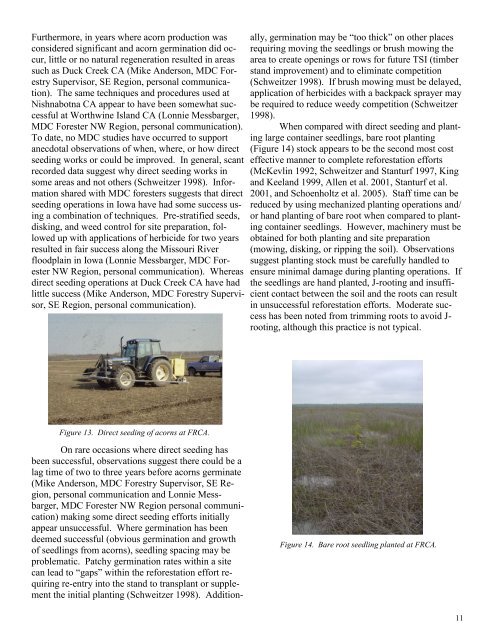Science and Management Technical Series_vol1_final.pdf - Upper ...
Science and Management Technical Series_vol1_final.pdf - Upper ...
Science and Management Technical Series_vol1_final.pdf - Upper ...
Create successful ePaper yourself
Turn your PDF publications into a flip-book with our unique Google optimized e-Paper software.
Furthermore, in years where acorn production was<br />
considered significant <strong>and</strong> acorn germination did occur,<br />
little or no natural regeneration resulted in areas<br />
such as Duck Creek CA (Mike Anderson, MDC Forestry<br />
Supervisor, SE Region, personal communication).<br />
The same techniques <strong>and</strong> procedures used at<br />
Nishnabotna CA appear to have been somewhat successful<br />
at Worthwine Isl<strong>and</strong> CA (Lonnie Messbarger,<br />
MDC Forester NW Region, personal communication).<br />
To date, no MDC studies have occurred to support<br />
anecdotal observations of when, where, or how direct<br />
seeding works or could be improved. In general, scant<br />
recorded data suggest why direct seeding works in<br />
some areas <strong>and</strong> not others (Schweitzer 1998). Information<br />
shared with MDC foresters suggests that direct<br />
seeding operations in Iowa have had some success using<br />
a combination of techniques. Pre-stratified seeds,<br />
disking, <strong>and</strong> weed control for site preparation, followed<br />
up with applications of herbicide for two years<br />
resulted in fair success along the Missouri River<br />
floodplain in Iowa (Lonnie Messbarger, MDC Forester<br />
NW Region, personal communication). Whereas<br />
direct seeding operations at Duck Creek CA have had<br />
little success (Mike Anderson, MDC Forestry Supervisor,<br />
SE Region, personal communication).<br />
Figure 13. Direct seeding of acorns at FRCA.<br />
On rare occasions where direct seeding has<br />
been successful, observations suggest there could be a<br />
lag time of two to three years before acorns germinate<br />
(Mike Anderson, MDC Forestry Supervisor, SE Region,<br />
personal communication <strong>and</strong> Lonnie Messbarger,<br />
MDC Forester NW Region personal communication)<br />
making some direct seeding efforts initially<br />
appear unsuccessful. Where germination has been<br />
deemed successful (obvious germination <strong>and</strong> growth<br />
of seedlings from acorns), seedling spacing may be<br />
problematic. Patchy germination rates within a site<br />
can lead to ―gaps‖ within the reforestation effort requiring<br />
re-entry into the st<strong>and</strong> to transplant or supplement<br />
the initial planting (Schweitzer 1998). Addition-<br />
ally, germination may be ―too thick‖ on other places<br />
requiring moving the seedlings or brush mowing the<br />
area to create openings or rows for future TSI (timber<br />
st<strong>and</strong> improvement) <strong>and</strong> to eliminate competition<br />
(Schweitzer 1998). If brush mowing must be delayed,<br />
application of herbicides with a backpack sprayer may<br />
be required to reduce weedy competition (Schweitzer<br />
1998).<br />
When compared with direct seeding <strong>and</strong> planting<br />
large container seedlings, bare root planting<br />
(Figure 14) stock appears to be the second most cost<br />
effective manner to complete reforestation efforts<br />
(McKevlin 1992, Schweitzer <strong>and</strong> Stanturf 1997, King<br />
<strong>and</strong> Keel<strong>and</strong> 1999, Allen et al. 2001, Stanturf et al.<br />
2001, <strong>and</strong> Schoenholtz et al. 2005). Staff time can be<br />
reduced by using mechanized planting operations <strong>and</strong>/<br />
or h<strong>and</strong> planting of bare root when compared to planting<br />
container seedlings. However, machinery must be<br />
obtained for both planting <strong>and</strong> site preparation<br />
(mowing, disking, or ripping the soil). Observations<br />
suggest planting stock must be carefully h<strong>and</strong>led to<br />
ensure minimal damage during planting operations. If<br />
the seedlings are h<strong>and</strong> planted, J-rooting <strong>and</strong> insufficient<br />
contact between the soil <strong>and</strong> the roots can result<br />
in unsuccessful reforestation efforts. Moderate success<br />
has been noted from trimming roots to avoid Jrooting,<br />
although this practice is not typical.<br />
Figure 14. Bare root seedling planted at FRCA.<br />
11


